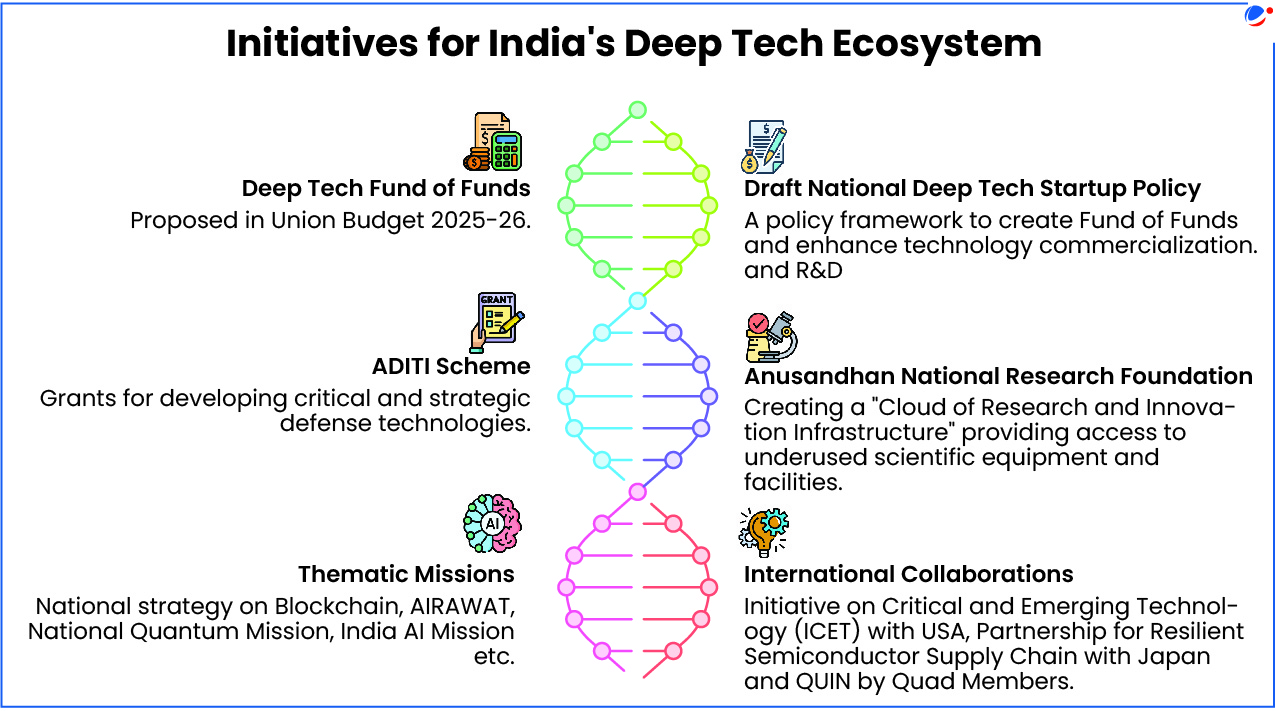
Why in the News?
Union Minister for Commerce and Industry urged Indian startups to focus more on Deep tech innovation.
What are Deep Tech Startups?
- Deep Technology or Deep Tech refers to innovations founded on advanced scientific and technological breakthroughs, encompassing various technologies (refer infographic).
- DeepTech startups utilize existing advanced technologies to create novel-to-market solutions for complex and often unresolved problems or to invent even more advanced technologies rooted in core science and engineering fundamentals.
Deep Tech Startup Ecosystem in India
- Extent: India's deep-tech ecosystem, currently at around 4,000 start-ups, is expected to reach 10,000 by 2030 according to estimates by the Department for Promotion of Industry and Internal Trade.
- Global Standing: Despite having third largest pool of DeepTech startups, India ranked 6th among the top 9 DeepTech ecosystems in the world in 2023 (Nasscom).
- Funding: As per Nasscom, India's 4,000 deep-tech startups attracted $1.6 billion in 2024, a 78 per cent increase year-on-year.
- Examples:
- Agnikul Cosmos startup launched the world's first rocket with a single-piece 3d-printed rocket engine.
- ImmunoAct, IIT Bombay and Tata Memorial Hospital developed an indigenous CAR-T cell therapy to treat Cancer.
- ideaForge Technology is revolutionizing the UAV market with its advanced drones.
Why are Deep Tech Startups lagging in India?
- Lagging Institutional Support: According to a study commissioned by the Office of the Principal Scientific Advisor, only one in six public-funded research and development organisations provide support to 'deep tech' startups in India

- Inconsistent Funding: In 2023, Indian Deep Tech startups saw a decline in funding over the previous year, but it increased in 2024.
- Also, India's venture capital (VC) landscape prioritises quick returns over patient capital.
- Long Gestation Period: Deep tech startup provides Extended development timelines and high capital intensity, and also carry large technical uncertainty, which presents a large risk.
- Focus on Consumption-Driven Startups: India's startup boom has largely been fuelled by consumer-facing businesses rather than deep-tech breakthroughs.
- Regulatory Hurdles: Lack of universal consensus in regulations relating to Deep Tech, policy uncertainty like scrapped angel tax, red tape and a risk-averse investment culture hinder progress.
- Education and Research Infrastructure: Indian universities rarely rank among global leaders in original research, and this quality gap results in the migration of Indian talent to foreign destinations.
- Limited Academia-Industry Collaboration: It hinders prototyping and commercializing of research outcomes, hindering the development of the Deep Tech ecosystem.

Way Forward
- Spinouts: Enabling and facilitating labs/institutes to generate more spinouts can lead to a self-perpetuating cycle of the generation of deep-tech startups and generate external revenue for labs/institutes to advance further research.
- Infrastructure Creation: Identify and strengthen innovation clusters, especially in five focus sectors (Medical Devices, Space, Defence, Agriculture, and Manufacturing).
- Also, establish dedicated R&D facilities with high-performance computing resources, simulation tools and testbed environments.
- Foster Investment Ecosystem: Establish co-investment programs with Venture Capitalists (VCs), introduce government-backed instruments and simplify regulatory processes related to VC investments.
- Also, India needs to bridge the gap in investor knowledge regarding DeepTech and address challenge of investor security through loan guarantees, regulatory sandboxes etc.
- Policy Incentives for R&D: Provide grants/access to regulatory sandboxes to prototype and test, facilitate platforms connecting startups with enterprises and introduce tax credits for DeepTech R&D expenditure.
- Implementation of National DeepTech Startup Policy (NDTSP): Develop a comprehensive roadmap for the implementation of NDTSP and establish monitoring and evaluation mechanisms to track the progress.



